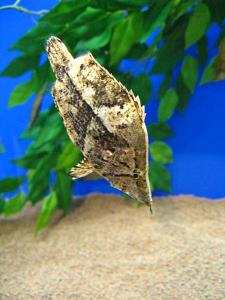South American Leaf Fish (Monocirrhus polyacanthus)

South American leaf fish (Monocirrhus polyacanthus) are unusual looking fish from the family Nandidae. Members of this family are predatory fish whose main diet consists of other fish.
The South American leaf fish is also often called the Amazon leaf fish.
Like other members of its family, the South American leaf fish is predatory, despite its relatively small size. It reaches an adult length of only a little of over 3 inches (7-8 cm) in length.
This fish has a laterally compressed body and coloration resembling a leaf, hence the name "leaf fish." They also have a small protrusion extending from their bottom lip.
Like most South American fish, leaf fish do best with soft, slightly acidic water, and a water temperature between 74-80 °F (23-27°C).
Leaf fish spend a good portion of their time oriented with their head facing toward the bottom of the tank, as shown in the photo on this page.
Their tank should be heavily planted, with dim lighting, and lots of hiding places.
Not only do these fish resemble a leaf in color and body shape, but even their movements resemble a leaf floating through the water. To see how this fish moves through the water watch the You Tube video below to see a South American leaf fish in its natural habitat.
Leaf fish are carnivorous fish and their diet consists of mainly small live fish. Keep this in mind when choosing their tank mates. They may also take live worms and brine shrimp, especially when young.
Males and females look similar to one another, although you may be able to see an ovipositor on the female when she is in breeding condition. Breeding sometimes occurs in the aquarium, especially in soft, acidic water. Filtering the water through peat and providing lots of hiding places will encourage them to breed.
During spawning, the pair will clean off a rock, leaf, or some other flat surface. After spawning takes place the male guards the eggs. Remove the female at this point.
After the eggs hatch in a few days and the fry are free swimming, feed them newly hatched brine shrimp.
